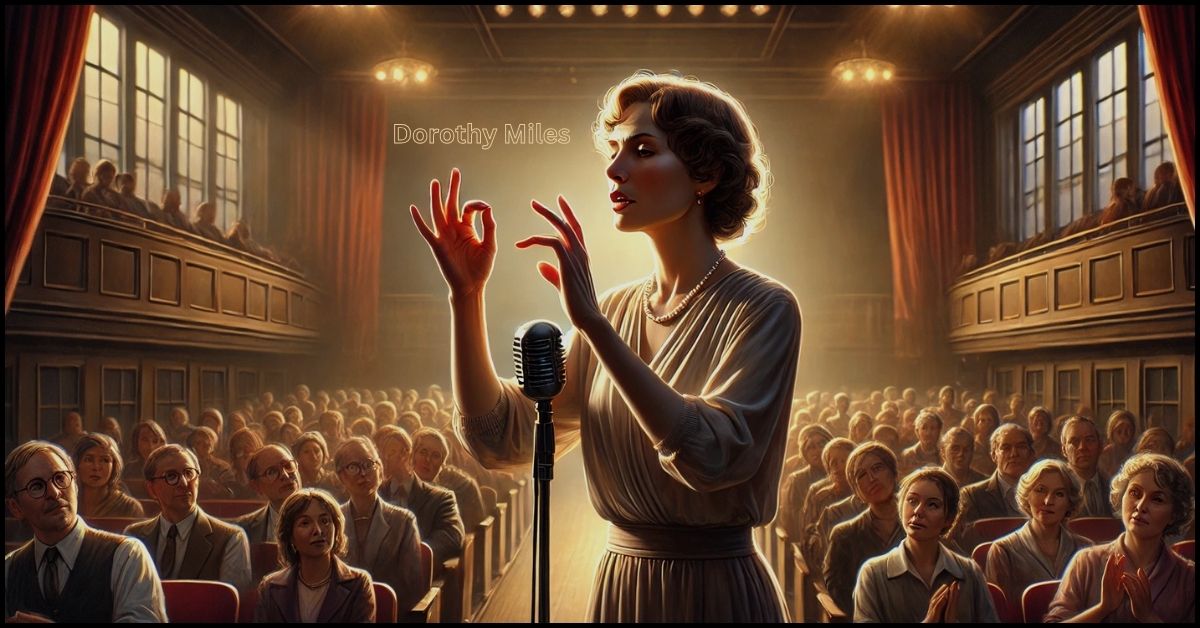Contents
Introduction to Dorothy Miles
Dorothy Miles was not just an artist; she was a groundbreaking pioneer who bridged the gap between the Deaf and hearing worlds through her exceptional contributions to sign language poetry. Her work resonated deeply, inspiring generations and bringing sign language to the forefront as a recognized form of artistic and linguistic expression.
This article delves into Dorothy Miles’ life, her achievements, and the legacy she left behind, highlighting her unique role in elevating sign language poetry and advocating for the Deaf community.
Early Life and Influences
Born in 1931 in Pontypridd, Wales, Dorothy Miles displayed an extraordinary talent for communication and artistic expression from a young age. Her experiences growing up in a community with a rich tradition of storytelling and music helped shape her appreciation for expressive forms. However, it was not until she lost her hearing in her teenage years due to a severe illness that she discovered her true calling. This profound change steered her life toward a path where she would become an influential figure in both Deaf and hearing communities.
Miles’ education at the Royal National Institute for Deaf People and subsequent experiences at Gallaudet College (now Gallaudet University) in Washington, D.C., played pivotal roles in her development. Gallaudet, the only higher education institution in the world specifically designed for Deaf and hard-of-hearing students, introduced Miles to American Sign Language (ASL) and its vibrant culture. Here, she cultivated her passion for the arts, blending her love of poetry with the nuances of sign language.
Contribution to Sign Language Poetry
Dorothy Miles is best known for pioneering sign language poetry, an art form that expresses the beauty of language through visual and kinetic movements rather than spoken or written words. Her poetry was unique, intricate, and profound, seamlessly intertwining ASL with English poetry to reach Deaf and hearing audiences. This was an innovative approach at the time, as it transformed how the world viewed sign language, not just as a tool for communication but as an artistic medium capable of profound expression and emotion.
The Essence of Her Poetry
Miles’ work focused on identity, unity, and the shared human experience. Her poems, performed in sign language, emphasized the rhythm, metaphor, and visual beauty inherent in movement. This opened the eyes of many, showcasing that sign language had its grammar, structure, and poetic potential.
One of her most notable works, “The Rose,” captured how ASL could create vivid imagery without a single spoken word. The fluidity of her hand movements, expressions, and body language illustrated how sign language could convey emotions as effectively as spoken poetry. Through her performances, she proved that poetry could be seen and heard, creating an inclusive platform for artistic expression.
Bridging the Gap Between Communities
Miles’ poetry served as a bridge between Deaf and hearing audiences, facilitating mutual appreciation and understanding. She fostered a deeper connection between these worlds by translating her sign language poems into written English and incorporating spoken language elements into her performances. Her efforts helped dissolve stereotypes and misconceptions about Deaf culture and sign language, demonstrating that both have rich, complex, and deeply artistic dimensions.
Advocating for the Deaf Community
Dorothy Miles’ influence extended beyond her artistic endeavors; she was a passionate advocate for the rights and recognition of the Deaf community. She understood that societal change required more than artistic contributions; it demanded active engagement and education. Miles collaborated with various organizations to promote accessibility and inclusivity, using her platform to push for more opportunities and recognition for Deaf artists and professionals.
Her workshops and lectures on the art of sign language poetry inspired others to explore and develop their artistic capabilities. By mentoring younger artists and working closely with educators, Miles played a crucial role in cultivating a new generation of Deaf poets who followed in her footsteps.
Challenges and Triumphs
Dorothy Miles’s journey was not without challenges. Navigating a world where the Deaf community faced systemic barriers and discrimination meant that her path was filled with obstacles. Her struggle to be understood and accepted by a broader audience underscored her resilience and determination.
Despite these challenges, Miles’ dedication never wavered. Her commitment to advocating for the Deaf community and her determination to showcase the beauty of sign language set her apart as an enduring force. Recognition did not come overnight, but her relentless pursuit of change paved the way for greater acknowledgment of sign language as a legitimate form of communication and art over time.
Personal struggles also marked her career. Miles battled mental health issues throughout her life, a reality that she addressed openly, bringing attention to the importance of mental well-being within the Deaf community. This revolutionary candidness fostered a more supportive environment for mental health discussions.
Legacy and Continued Influence
Dorothy Miles passed away in 1993, but her legacy remains alive and vibrant. She laid the foundation for modern sign language poetry and inspired countless artists to explore the intersection of language and movement. Her work has been celebrated in numerous festivals, workshops, and scholarly articles that continue to study her influence.
Today, Deaf poets and performers carry forward her vision, creating art that bridges linguistic and cultural divides. Dorothy Miles’ pioneering work owes much to recognizing sign language as an art form. Her contributions are taught in educational institutions and serve as a blueprint for aspiring sign language poets worldwide.
FAQs
Who was Dorothy Miles?
Dorothy Miles was a trailblazing poet and advocate who transformed sign language into a recognized art form. Through her innovative approach to poetry, she was instrumental in bridging the gap between the Deaf and hearing communities.
What is Dorothy Miles known for?
Miles is best known for pioneering sign language poetry and advocating for the rights of the Deaf community. Her unique blend of ASL and English poetry expanded the possibilities of artistic expression for Deaf and hearing audiences alike.
Why is sign language poetry significant?
Sign language poetry demonstrates that language can be more than auditory or written; it can be visual and kinetic. This art form allows Deaf individuals to express emotions and ideas using the full range of movement and facial expression, giving it a rich, unique dimension.
What were some of Dorothy Miles’ significant works?
One of her most famous pieces is “The Rose,” a performance that beautifully illustrates sign language poetry’s visual nature. Her works often focused on identity, community, and shared human experiences.
How did Dorothy Miles influence future generations?
Miles’ influence is seen in the continued evolution of sign language poetry and the increasing recognition of Deaf culture in mainstream art and literature. Her mentorship and advocacy paved the way for new generations of Deaf artists and poets.
What challenges did Dorothy Miles face?
Dorothy Miles faced both personal and societal challenges, including discrimination against the Deaf community and struggles with mental health. Despite these obstacles, her work continued to inspire and advocate for change.
Conclusion
Dorothy Miles was more than a poet; she was a visionary who changed the perception of sign language and its capabilities. Her innovative work in sign language poetry enriched the arts and strengthened the bridge between Deaf and hearing communities. Miles proved through her life’s journey that true artistry knows no bounds, and her legacy continues to influence and inspire artists worldwide.
Ethan Cole is a versatile writer at hsnime.co.uk, offering fresh perspectives and engaging content across various topics. With a passion for creativity and knowledge, Ethan aims to provide insightful articles that resonate with a diverse audience.






